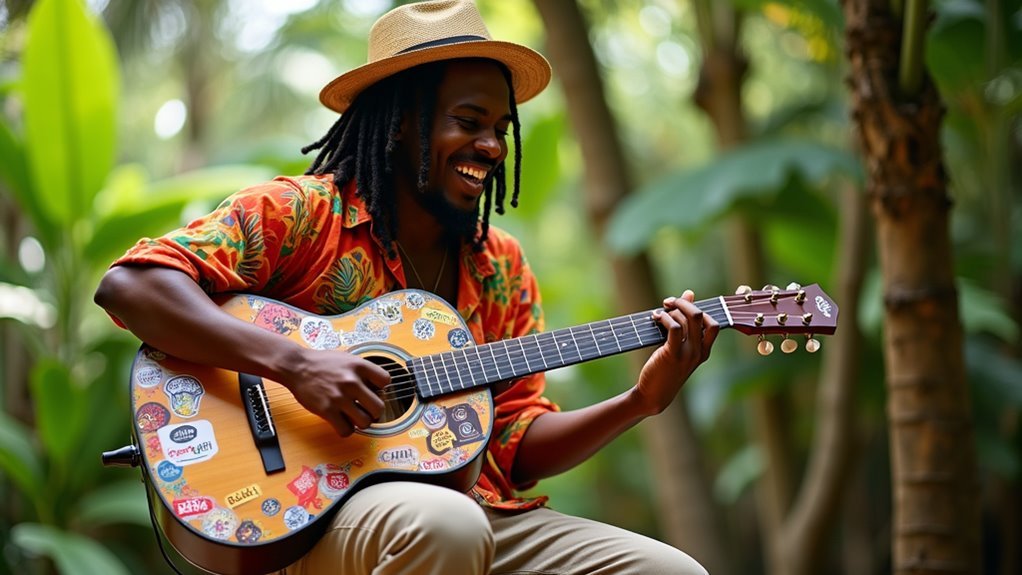Let’s cut straight to what makes reggae guitar distinctive: that irresistible offbeat rhythm and those chunky, muted chords. We’ll transform your playing from stiff to smooth, teaching you the exact techniques that define classics from Bob Marley to Steel Pulse. If you’ve been struggling to nail that authentic island groove, you’re in the right place. There’s a method to mastering reggae’s signature sound, and we’re about to crack the code.
Essential Reggae Strumming Patterns and Techniques

Three core elements define authentic reggae guitar: syncopated offbeat strumming, muted chord techniques, and precise rhythmic control.
Let’s break down these essential strumming patterns that’ll transform your playing reggae from amateur to authentic.
Start with the foundational pattern: down-strokes on the offbeats, always hitting the “and” of each beat. Master this muted first – it’ll force you to nail the rhythm without getting lost in ringing notes.
We’ll add upstrokes later to create that signature reggae sound you’re after.
Don’t skip those barre chords – they’re your ticket to clean, punchy voicings. Practice partial barres until they’re second nature.
Mastering the Signature Reggae Guitar Sound
The signature reggae guitar sound lives in the delicate balance between precision and groove.
We’ll show you how to nail that authentic reggae guitar playing through strategic offbeat strumming and muted chord techniques.
Let’s start with offbeat emphasis – it’s all about hitting those “and” beats in 4:4 time.
We’re not just strumming randomly; we’re creating that iconic reggae rhythm.
Master the muted chord technique by releasing string pressure after strumming, and mix in partial barre chords with open positions for that classic sound.
Mastering reggae guitar requires finesse – let your chords breathe through strategic muting and a mix of playing positions.
Watch your hand positioning and pressure – they’re essential for that laid-back reggae feel.
While effects like reverb can enhance your sound, we’ll focus on perfecting clean tone first.
Remember: authentic reggae music starts with solid fundamentals, not fancy effects.
Building Your Reggae Chord Vocabulary

Building a versatile reggae chord vocabulary starts with mastering foundational open chords before diving into more complex variations.
We’ll focus on essential chords like G, C, D, Em, and Am – the building blocks of classic reggae songs. These fundamentals create the signature sound of reggae when combined with proper muting techniques.
Let’s nail these core elements:
- Practice major and minor progressions like G-Em-C-Am to understand reggae’s harmonic DNA
- Master muting techniques for that tight, percussive skank that defines reggae playing
- Explore higher register voicings that won’t clash with bass guitar lines
Once you’ve got these basics down, experiment with partial barre chords and sparse voicings.
This progression from simple to complex chords will help you develop an authentic reggae sound while maintaining proper rhythm and feel.
Rhythm Development and Timing Exercises
Mastering chord shapes won’t mean much if you can’t nail reggae’s signature rhythm.
Let’s turn you into a timing machine with exercises straight from Bob Marley’s playbook.
Start by muting your strings and focusing purely on strumming patterns. Hit those offbeats – the “and” between beats – that’s where reggae’s soul lives.
Add foot-tapping to lock in your internal metronome; it’s not optional, it’s essential.
Mix up your attack with alternating down-up strokes on the offbeat. It’s not just about technique; it’s about feeling the groove.
The secret to authentic reggae lies in mastering those offbeat strokes – let your guitar breathe between the beats.
Practice with your favorite reggae tracks until the rhythm becomes second nature. Remember: timing isn’t just counting beats – it’s the difference between playing reggae and living it.
Want results? Dedicate 15 minutes daily to these exercises. No shortcuts, just solid progress.
Advanced Performance Elements and Effects

Ready to transform your reggae playing from basic to brilliant?
Let’s plunge into advanced effects that’ll elevate your style of music. Starting with a clean C major tone helps us build a solid foundation before layering effects like reverb and delay for depth.
- Master the wah-wah pedal for expressive textures
- Experiment with string pressure modulation for dynamic flair
- Incorporate triadic flourishes in higher registers
Want to learn more about reggae effects?
We’re combining traditional rhythms with modern sophistication. By focusing on spaciousness and clarity in your sound, you’ll create an immersive experience that defines professional-grade reggae guitar.
Drop us an email address for our advanced techniques workshop, where we’ll explore these elements in detail.
Remember: great effects enhance your playing – they don’t mask it.
Frequently Asked Questions
What Is the Best Guitar Effect for Reggae?
We recommend starting with reverb settings and delay effects as they’re essential for reggae’s signature sound, while modulation effects, overdrive tones, and distortion choices can add character when used sparingly.
What Is the Reggae Guitar Style Called?
We’d call it “skank,” and while it sounds like something fishy, it’s the signature reggae guitar upstroke that legends like Peter Tosh and Bob Marley used to create those irresistible offbeat rhythms.
What Chords Does Reggae Use?
We’ll find reggae chord progressions using major seventh, minor seventh, and dominant seventh chords, with common substitutions occurring between G, C, D, and Em for that authentic reggae feel.
What Is the Reggae Strumming Pattern?
We’ll focus on offbeat rhythm by strumming on the “and” beats, using guitar techniques like string muting and strumming dynamics to create classic reggae grooves at various tempo variations.